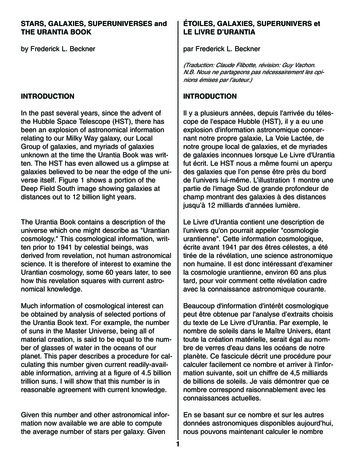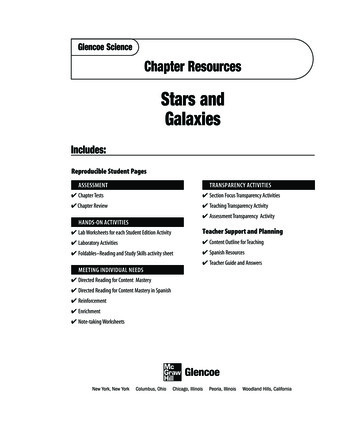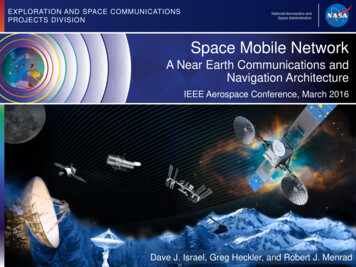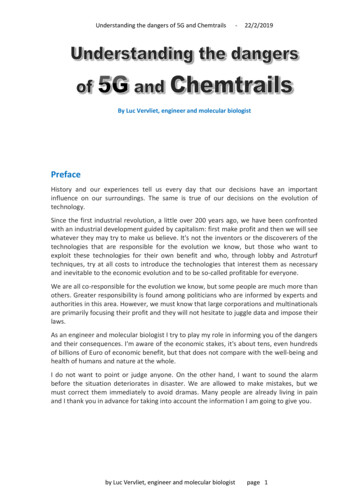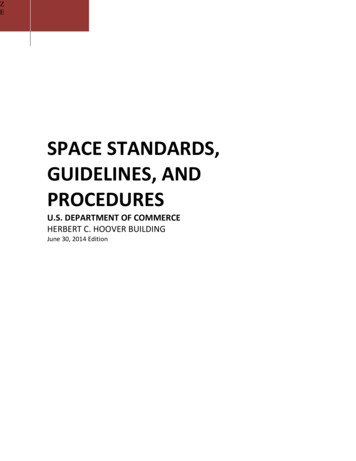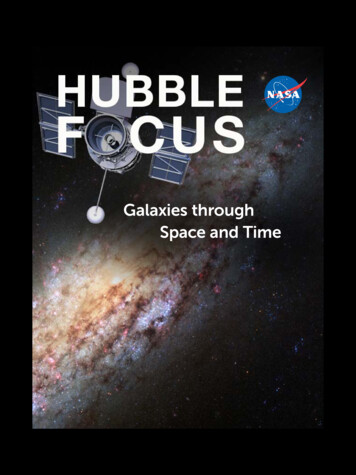
Transcription
Galaxies throughSpace and Time
ContentsINTRODUCTION . . . . . . . . . . . . . . . . . . . . . . . . . . . . . . . . . . . . . . . . 4About the Hubble Space Telescope . . . . . . . . . . . . . . . . . . . . . . . . . . . . . 5Our Understanding of Galaxies: A Timeline . . . . . . . . . . . . . . . . . . . . . . . 7CHAPTER 1: Our Galactic Neighborhood . . . . . . . . . . . . . . . . . . . . . . . . . 10Seeking the Source of Falling Gas . . . . . . . . . . . . . . . . . . . . . . . . . . . . . . . . . . . .12Studying Ancient Stars in the Milky Way . . . . . . . . . . . . . . . . . . . . . . . . . . . . . . . . 14Tracing the Origin of an Intergalactic Cloud . . . . . . . . . . . . . . . . . . . . . . . . . . . . . . 16Surveying Star Clusters in the Andromeda Galaxy . . . . . . . . . . . . . . . . . . . . . . . . . . 17Measuring a Giant Halo around the Andromeda Galaxy . . . . . . . . . . . . . . . . . . . . . . . 19CHAPTER 2: Intriguing Galaxies across the Universe . . . . . . . . . . . . . . . . . 20Excavating a Prehistoric Galaxy in Our Cosmic Backyard . . . . . . . . . . . . . . . . . . . . .22Witnessing a Rash of Star Formation in Long-Quiet Dwarf Galaxies . . . . . . . . . . . . . . . 23Investigating New Star Birth in a Tiny ‘Tadpole’ Galaxy . . . . . . . . . . . . . . . . . . . . . . . 25Seeing Star Formation in Elliptical Galaxies . . . . . . . . . . . . . . . . . . . . . . . . . . . . . . 27Finding a Relic Galaxy Close to Home . . . . . . . . . . . . . . . . . . . . . . . . . . . . . . . . . . 29Identifying the Spark that Ignites Quasars . . . . . . . . . . . . . . . . . . . . . . . . . . . . . . . 31Detecting a Double Black Hole . . . . . . . . . . . . . . . . . . . . . . . . . . . . . . . . . . . . . .32CHAPTER 3: The Farthest Galaxies . . . . . . . . . . . . . . . . . . . . . . . . . . . . . 34Discovering a Distant ‘Dead’ Disk Galaxy . . . . . . . . . . . . . . . . . . . . . . . . . . . . . . . . 36Detailing the Universe’s Brightest Infrared Galaxies . . . . . . . . . . . . . . . . . . . . . . . . . 37Uncovering a Stretched-Out Galaxy from the Very Early Universe . . . . . . . . . . . . . . . .39Spotting the Faintest Galaxy Yet Seen in the Distant Universe . . . . . . . . . . . . . . . . . . . 40Pushing the Limits of Our Cosmic View . . . . . . . . . . . . . . . . . . . . . . . . . . . . . . . .42SUMMARY . . . . . . . . . . . . . . . . . . . . . . . . . . . . . . . . . . . . . . . . . . . . 43MORE INFORMATION . . . . . . . . . . . . . . . . . . . . . . . . . . . . . . . . . . . . 44CREDITS . . . . . . . . . . . . . . . . . . . . . . . . . . . . . . . . . . . . . . . . . . . . . 452
This deep Hubble image captures many of the hundreds of galaxies that belong to the massive galaxy cluster Abell 2744, located 3.5 billion lightyears from Earth. In the background are small, faint galaxies that lie even farther in the distance, some more than 12 billion light-years away.Credit: NASA, ESA, and J. Lotz, M. Mountain, A. Koekemoer, and the Hubble Frontier Fields Team (STScI)3
INTRODUCTIONThis e-book is part of a series called Hubble Focus. Each book will present some of Hubble’s more recent andimportant observations within a particular topic. The subjects will span from our nearby solar system out tothe horizon of Hubble’s observable universe.This book, Hubble Focus: Galaxies through Space and Time, highlights some of Hubble’s recent discoveriesabout the homes of stars, nebulas, and planets: galaxies—from our very own galaxy, the Milky Way, to themost distant galaxies anyone has ever seen. Hubble’s recent contributions are often in partnership with otherspace telescopes as well as those on the ground, and build on decades of discoveries that came before Hubble’slaunch. Its findings are helping us understand how our universe has come to be the way it is today.Sparkling with new star formation, spiral galaxy NGC 6744 is similar in shape to our Milky Way galaxy but is more than double the size.Credit: NASA, ESA, and the Legacy ExtraGalactic UV Survey (LEGUS) team4
About the Hubble Space TelescopeSince its launch in 1990, NASA’s Hubble Space Telescope has made more than one million observations,amassed a huge archive of scientific findings, and had a profound effect on all areas of observationalastronomy. Hubble has addressed fundamental cosmic questions and explored far beyond the most ambitiousplans of its builders. It has discovered that galaxies evolve from smaller structures, found that supermassiveblack holes are common at the centers of galaxies, verified that the universe’s expansion is accelerating,probed the birthplaces of stars inside colorful nebulas, analyzed the atmospheres of extrasolar planets, andsupported interplanetary missions. The rate of discovery with Hubble is simply unparalleled for any telescopein the history of astronomy.Hubble observes the universe from Earth orbit, just outside our planet’s atmosphere.Credit: NASAAs NASA’s first Great Observatory and the first major optical telescope in space, Hubble ushered in a new eraof precision astronomy. The heart of the telescope is its 94.5-inch-diameter primary mirror. It is the smoothestoptical mirror ever polished, with no deviations greater than one-millionth of an inch.Operating above Earth, free from the blurring and filtering effects of our planet’s atmosphere, Hubble canresolve astronomical objects ten to twenty times better than typically possible with large ground-basedtelescopes. It also can observe those objects across a range of the electromagnetic spectrum, from ultravioletlight through visible and to near-infrared wavelengths.5
Hubble can detect objects as faint as 31st magnitude, which is about 10 billion times fainter than the humaneye can see. The telescope can see faint objects near bright objects—an important requirement for studyingthe regions around stars and close to the glowing nuclei of active galaxies. Astronomers have used Hubble’ssharp vision to probe the limits of the visible universe, uncovering never-before-seen objects that existed notlong after the birth of the universe in the Big Bang.Hubble’s view is optically stable, meaning the quality of its observing conditions never changes from day today or even orbit to orbit. Hubble can revisit celestial targets with the same acuity and image quality over andover again. This is crucial for precision observations in which astronomers try to detect small changes in thelight, motion, or other behavior of a celestial object.Hubble is more technologically advanced now than it was when launched, thanks to the maintenance andupgrades provided by five space shuttle servicing missions between 1993 and 2009. Hubble is expected tocontinue operating well beyond 2020.Astronauts John Grunsfeld and Andrew Feustel replace a Fine Guidance Sensor on Hubble during the last servicing mission in May 2009.Credit: NASA6
Our Understanding of Galaxies: A TimelineGalaxies are cosmic islands of stars, planets, nebulas, gas, dust, and dark matter that are separatedfrom one another in space but collectively help to tell the story of the universe. With the HubbleSpace Telescope, we have begun to understand galaxies as time capsules that chronicle how theuniverse evolved, from the birth of stars within them to the buildup of immense galaxy clusters.However, this modern realization of the cosmic role and significance of galaxies, including ourown, took centuries to emerge.1610Italian scientist Galileo Galilei uses a newly invented instrument—the telescope—to resolvethe band of light running across the night sky, known as the Milky Way, into myriad starsthat he presumes must be at a great distance.1750English astronomer Thomas Wright speculates that some fuzzy patches in the night skycalled nebulae (or nebulas) are external galaxies like the Milky Way, far beyond our own.1771French comet-hunter Charles Messier publishes the first version of his catalog of nonstellar objects, which eventually includes over three dozen galaxies even though he has noidea of their nature or great distances.1845William Parsons, Ireland’s third Earl of Rosse, uses the world’s largest telescope of the timeto resolve spiral nebulae such as M51 (known today as the Whirlpool galaxy). Astronomerslargely assume it is a nearby whirlpool of gas because no stars can be resolved.1920At the Great Debate, held before a public audience in Washington, DC, astronomers HarlowShapley and Heber Curtis argue whether spiral nebulae are part of our galaxy or outside ofit.1924American astronomer Edwin Hubble publishes a paper demonstrating that M31, knownthen as the Andromeda Nebula, lies far outside our own galaxy. He later develops anevolutionary sequence of galaxy types in an attempt to organize his observations. Hubblealso uses galaxies as “markers of space” to measure the expansion rate, and hence the age,of the universe.1932Studies of galaxy motion (building on earlier studies of stellar motion) provide evidencethat an invisible form of matter, later dubbed dark matter, dominates the universe. Galaxiescontain only a small fraction of the mass in the universe.7
1964The discovery of the cosmic microwave background provides observational evidencefor the Big Bang hypothesis. This means that galaxies must have evolved from a hot anddense fireball.1970sAstronomers Vera Rubin and Kent Ford confirm the existence and dominance of darkmatter in galaxies by measuring the motions of stars within.1990NASA’s Cosmic Background Explorer (COBE) reveals minor temperature fluctuations in theearly universe that led to the amalgamation of matter and the formation of early galaxies.1994Hubble confirms the existence of a supermassive black hole in the core of galaxy M87.Subsequent Hubble surveys find that such black holes are common to galaxies and that ablack hole’s mass correlates with the mass of its parent galaxy.1995The Hubble Deep Field finds thousands of galaxies, including many very distant ones, in acomparatively blank-looking patch of sky.1996High-resolution imaging from Hubble definitively shows that brilliant objects knownas quasars are located at the cores of faint, distant galaxies. Many quasar host galaxiesinteract with neighboring galaxies, which fuels activity near supermassive black holes atgalactic cores.1998Observations of supernovas in distant galaxies show that the expanding universe isaccelerating. Astrophysicists hypothesize that this is caused by an unknown form ofenergy, labeled “dark energy,” that permeates all of space, pushing the galaxies fartherapart at an ever-increasing rate.2003NASA’s Wilkinson Microwave Anisotropy Probe (WMAP) produces an even higher-qualitymap of the cosmic microwave background showing fine structure in the early universe,which led to the distribution of mass and galaxies observed in the universe today.2014A ten-year compilation of observations allows astronomers to assemble the mostcomprehensive picture of the evolving universe, spanning ultraviolet to near-infraredwavelengths, in a small patch of sky known as the Hubble Ultra Deep Field.8
This image of the Hubble Ultra Deep Field, released in 2014, is a colorful and comprehensive view of the evolving universe, capturing approximately10,000 galaxies seen across space and time. The image combines Hubble observations taken in visible, infrared, and ultraviolet light between 2002and 2012.Credit: NASA, ESA, H. Teplitz and M. Rafelski (IPAC/Caltech), A. Koekemoer (STScI), R. Windhorst (Arizona State University), and Z. Levay (STScI)9
CHAPTER 1: Our Galactic NeighborhoodA mere century ago, most astronomers believed that everything we could see in the night sky belonged toone galaxy, our own Milky Way. Yet, there were doubts. Some suspected that fuzzy patches of light known asnebulas were actually distant “islands of stars” far beyond our galaxy. Still, no one knew for sure until 1923,when Edwin Hubble used the world’s largest telescope, perched atop Mount Wilson in California, to measurethe distance to the Great Andromeda Nebula, proving that it was much too far away to belong to our galaxy.The Andromeda galaxy, as we know it today, is the Milky Way’s biggest galactic neighbor. The Milky Way andAndromeda are actually the largest members of the Local Group, a collection of nearby galaxies bound togetherby gravity. These two companions are spiral galaxies, each sporting star-filled arms that wrap around a bright,dense core of older stars. And each is surrounded by a number of small, oddly shaped satellite galaxies knownas irregular dwarf galaxies. Observations made with Hubble and other telescopes suggest that spiral galaxiessuch as the Milky Way and Andromeda grew as dwarf galaxies merged, and that they continue to grow largereven now by pulling in and absorbing these smaller galactic satellites.In fact, the Milky Way and Andromeda galaxies are on a collision course of their own, fated to crash into eachother and unite into an even larger galaxy billions of years in the future. Computer simulations fed by Hubbleobservations of Andromeda’s motion show that the dramatic encounter, predicted to begin four billion yearsfrom now, will be a head-on impact, flinging our Sun and its planets into a different part of the galaxy, andtaking about two billion years to eventually settle into the much larger, oval-shaped, elliptical galaxy.More than 7,000 Hubble exposures were combined to create this grand mosaic of a portion of the Andromeda galaxy. Even though the galaxy is 2.5million light-years away, Hubble’s view resolves individual stars in the galaxy’s disk—more than 100 million of which are captured here.Credit: NASA, ESA, J. Dalcanton, B.F. Williams, and L.C. Johnson (University of Washington), the PHAT team, and R. Gendler10
These two spiral galaxies are similar to the Milky Way and Andromeda, but they look quite different from each other. That’s because the galaxy onthe left (called NGC 4302) is turned to the side so we see it edge-on, while the one on the right (NGC 4298) appears face-on so we get a full viewof its spiral shape.Credit: NASA, ESA, and M. Mutchler (STScI)11
Seeking the Source of Falling GasAn invisible but immense cloud of gas is plummeting toward our galaxy atnearly 700,000 miles per hour, but until recently, astronomers did not knowwhere it was coming from. Named the Smith Cloud after astronomy studentGail Smith, who discovered it in the 1960s, the comet-shaped clump of gas isan estimated 11,000 light-years long and 2,500 light-years across. Astronomerssuspected it might be a failed, starless galaxy, or gas falling into the Milky Wayfrom intergalactic space. However, when they called upon Hubble to study itscomposition, they found that it was not likely to be either one of those things.By using Hubble to examine the light from distant galaxies that filtered throughthe Smith Cloud, astronomers found out that the cloud has just as much sulfuras the outer part of the Milky Way’s disk. This was surprising, because that muchsulfur can only be supplied by previous generations of stars, which would nothave existed in a cloud of pristine hydrogen from outside our galaxy or in theremnant of a failed galaxy lacking stars. The likeliest explanation is that the gaswas ejected from the Milky Way itself about 70 million years ago and is nowon a return collision course. Astronomers expect the gas cloud to plow into theMilky Way’s disk in about 30 million years. When it does, it will likely ignite aspectacular burst of star formation, perhaps providing enough gas to forge 2million suns. Hubble’s observations are helping astronomers understand howour galaxy is recycling material and continuing to evolve.“The Milky Way isa bubbling, veryactive place wheregas can be thrownout of one part ofthe disk and thenreturn back downinto another.”Andrew Fox, Space TelescopeScience InstituteTrajectory of Smith Cloud70 Million Years AgoTodayThese panels illustrate the trajectory of the Smith Cloud, from whenit left the Milky Way’s disk, through today, and to when it will return tothe disk in the future.Illustration credit: NASA, ESA, and A. Feild (STScI)Learn more:30 Million Years from 016/news-2016-04.html12
PIERCING THE MILKY WAY’S HEARTUsing its infrared vision, Hubble pierced the dust-enshrouded heart of our Milky Way galaxy to reveal more than half a million stars at its core, some27,000 light-years away. By using Hubble to study the motions of some of these stars over four years, astronomers were able to calculate the massand structure of the stars packed into this central region. The incredibly dense area is so full of stars it would be like having a million suns crammedinto the space between our Sun and its closest neighbor, Alpha Centauri, 4.3 light-years away. These stars surround a supermassive black hole, 4million times as massive as our Sun, at the center of our galaxy. This movie zooms into Hubble’s view starting from a ground-based image of theMilky Way.Credit: NASA, ESA, and G. Bacon (STScI)13
Studying Ancient Stars in the Milky WayConducting a “cosmic archaeological dig” at the center of our Milky Waygalaxy, astronomers used Hubble to uncover a population of ancient whitedwarfs—smoldering remnants of once-vibrant stars that inhabited the core. Theobservations are the deepest, most detailed study of the galaxy’s foundationalstructure—its vast central bulge, which lies in the middle of a pancake-shapeddisk of stars (where our solar system dwells). Finding these relics can yield cluesto how our galaxy was built, long before our Earth and Sun formed.Hubble’s observations support the idea that the Milky Way’s bulge formed beforeits disk did, and that the bulge’s stellar inhabitants were born in a relativelyquick 2 billion years or less. The rest of the galaxy’s sprawling disk of secondand third-generation stars grew more slowly in the suburbs, encircling thecentral bulge. The Hubble survey also found slightly more low-mass stars inthe bulge, compared to those in the galaxy’s disk, suggesting that the star-birthenvironment in the bulge was different than it was in the disk.“The environmentin the bulgemay have beendifferent thanthe one in thedisk, resultingin a differentstar-formationmechanism.” Annalisa Calamida, SpaceTelescope Science InstituteAt left, a ground-based image of our Milky Way shows where Hubble peered in its search for white dwarfs at the center of the galaxy. Hubble’s imagein the upper right is marked with the locations of four of the brightest white dwarfs the telescope found (shown in the lower right).Credit: NASA, ESA, A. Calamida and K. Sahu (STScI), and the Sagittarius Window Eclipsing Extrasolar Planet Search (SWEEPS) Science Team (Hubble images); A. Fujii (ground-based Image)Learn more: /news-2015-38.html14
SWEEPING FOR WHITE DWARFSWithin this sparkling field of stars, astronomers identified 16 white dwarfs in the bulge of our galaxy, the Milky Way. Located 26,000 light-years away,these ancient stellar relics hold clues to how our galaxy grew and developed in its early years. This image, taken by Hubble’s Advanced Camera forSurveys, shows a small section of the Sagittarius Window Eclipsing Extrasolar Planet Search (SWEEPS) field. Astronomers managed to pick out thewhite dwarfs among all of these stars by painstakingly analyzing the motion, brightness, and color of individual stars.Credit: NASA, ESA, A. Calamida and K. Sahu (STScI), and the SWEEPS Science Team15
Tracing the Origin of an Intergalactic CloudJust beyond the edges of our galaxy, two nearby dwarf galaxies are engagedin a cosmic tug-of-war. These galaxies, the Large Magellanic Cloud and SmallMagellanic Cloud, orbit our Milky Way and gravitationally pull on one anotheras they do. Over the past billion years or two, one of the galaxies has torn ahuge cloud of gas out of the other—a structure that stretches half the length ofour galaxy and connects the Magellanic Clouds to the Milky Way. This cloudis supplying fresh material to our galaxy, which feeds new star formation.Astronomers call it the Leading Arm because it extends out ahead of theMagellanic Clouds in the direction of their motion. However, until recently, theydid not know which of the two dwarf galaxies was responsible for pulling thisgas from the other and from which galaxy the gas was coming.“We can measurethe compositionand velocity of thegas to determinewhich dwarfgalaxy is theculprit.”Kat Barger, Texas ChristianUniversityAstronomers used Hubble to study what the Leading Arm is made of to seewhether it was more like the Small Magellanic Cloud or the Large MagellanicCloud. They analyzed the light from seven quasars (the bright cores of activegalaxies) billions of light-years behind the Leading Arm. Hubble’s CosmicOrigins Spectrograph measured how much light was absorbed by differentelements in the Leading Arm’s gas. These measurements, combined withobservations from the Green Bank Telescope radio observatory, suggested thegas in the Leading Arm came from the Small Magellanic Cloud, and that it wasthe Large Magellanic Cloud winning that gravitational tug-of-war.QuasarsLeadingArmBACLMCSMCMagellanic StreamSpectrum of Quasar ASpectrum of Quasar BSpectrum of Quasar CSignal strengthSignal strengthSignal strengthRadio images, colored in pink, overlaid on a visible-light image of our Milky Way, show the locations of the Leading Arm (upper right), the Large andHH the Magellanic Stream (bottom). AstronomersHSmall Magellanic Clouds (lower right), andArm toO studied the light from quasars behind the LeadingOOdetermine its composition and origin.Illustration credit: D. Nidever et al., NRAO/AUI/NSF and A. Mellinger, Leiden-Argentine-Bonn (LAB) Survey, Parkes Observatory, Westerbork Observatory, Arecibo Observatory, and A. Feild (STScI)Learn more: /news-2018-15.html160 180 200 220 240 260 280 300Velocity (km/s)6080100 120 140 160 280 300Velocity (km/s)100150200Velocity (km/s)25030016
Surveying Star Clusters in the Andromeda GalaxyA detailed Hubble survey of our largest galactic neighbor, the Andromeda galaxy,allowed astronomers to make a surprising discovery: the percentages of massive starsand low-mass stars in Andromeda’s star clusters are similar to what’s found in ourMilky Way. This suggests that the universe follows a formula when creating new stars,producing a consistent distribution of stellar types, from massive blue supergiants tosmall red dwarfs, every time. Astronomers did not expect this stellar-mass ratio to beso similar in both galaxies, given the complex physics involved in star formation. Thisinsight will help them better interpret the light from distant galaxies and understandhow stars formed throughout the universe’s history.The Panchromatic Hubble Andromeda Treasury (PHAT) program captured nearly8,000 images of 117 million stars and 2,753 young, blue star clusters in the Andromedagalaxy. Astronomers recruited the help of 30,000 “citizen scientist” volunteers, whosifted through the thousands of Hubble images to search for these star clusters, whichrange in age from 4 million to 24 million years old. One specific finding from theanalysis was that the most massive stars in the clusters are 25 percent less abundantthan previously predicted. This implies that astronomers were underestimating thenumber of smaller stars forming alongside the massive stars and thus underestimatingthe masses of distant star clusters and galaxies. The results also indicate that the earlyuniverse did not have as many heavy elements for making planets, because therewere fewer supernovas from massive stars to produce those elements.“Given thesheer volumeof Hubbleimages,our study would nothave beenpossiblewithout thehelp of citizenscientists.”Daniel Weisz, Universityof WashingtonThe sweeping panorama of the nearby Andromeda galaxy at top spans more than 61,000 light-years of our galaxy’s large neighbor. A box showsa small region of the galaxy where six star clusters are highlighted in the lower left. Close-up views of those star clusters appear in the lower right.Credit: NASA, ESA, J. Dalcanton, B.F. Williams, and L.C. Johnson (University of Washington), the PHAT team, and R. GendlerLearn more: /news-2015-18.html17
ZOOMING IN TO A MASSIVE MOSAICMore than 7,000 Hubble exposures were combined to create a grand mosaic of a portion of the Andromeda galaxy. Even though the galaxy is 2.5million light-years away, Hubble’s view resolves more than 100 million individual stars in the galaxy’s disk. This movie begins with a wide view of thesky and zooms in to reveal some of the individual stars Hubble saw within the galaxy.Credit: NASA, ESA, and G. Bacon (STScI); Acknowledgment: A. Mellinger, Digitized Sky Survey (STScI/AURA, Palomar/Caltech, and UKSTU/AAO), J. Dalcanton (University of Washington), the PHAT team, and R. Gendler18
Measuring a Giant Halo around the Andromeda GalaxyAnalyzing five years’ worth of archived Hubble observations, astronomers discoveredthat the immense halo of gas enveloping the Andromeda galaxy is about six timeslarger and a thousand times more massive than previously thought. The dark, nearlyinvisible halo stretches about a million light-years from its host galaxy, halfway to ourown Milky Way galaxy. There is so much hot gas in this immense halo that its massis half that of all the stars in the galaxy itself. If it could be viewed with the nakedeye, the halo would be 100 times the diameter of the full Moon in our sky.However, the gas in Andromeda’s halo is dark. So astronomers used Hubble to studyquasars—the bright cores of distant galaxies—located behind Andromeda to see howthe quasar light was affected as it passed through the gas. By measuring how mucha quasar’s light is dimmed at certain wavelengths, astronomers could determinehow much gas is in Andromeda’s halo between us and the quasar. In addition todetermining the size and mass of the halo, astronomers also determined that it isenriched in elements much heavier than hydrogen and helium, which only comefrom exploding stars called supernovas. These findings offer more insight about theevolution and structure of giant spiral galaxies, one of the most common types ofgalaxies in the universe.“The propertiesof thesegaseous haloscontrol therate at whichstars form ingalaxies.”Nicolas Lehner, Universityof Notre DameBrightnessBrightnessNo halo detectedHalo medagalaxyNo halo detected2 million light-years4 million light-yearsThis diagram illustrates how astronomers determined the size of the halo around the Andromeda galaxy. When light from a distant quasar passedthrough the halo, Hubble saw that some of the light was absorbed. When light did not pass through the halo, there was no absorption.Illustration credit: NASA, ESA, and A. Feild (STScI)Learn more: /news-2015-15.html19
CHAPTER 2:Intriguing Galaxies across the UniverseHubble’s exceptional views of the cosmos have allowed astronomers to examine galaxies better than theyever could before, resolving features that would otherwise elude detection. Its observations continually revealintriguing galaxies with surprising features, both near and far, showing how different they can be from oneanother, but also how they relate.Hubble, like all telescopes, is a time machine that astronomers can use to see into the past. Because light fromthe universe does not reach us instantly but takes time to travel vast cosmic distances, Hubble reveals galaxiesnot as they are today, but as they appeared when their light left those galaxies millions or billions of years ago.The farther the galaxy Hubble studies, the farther back in time it sees. Faraway galaxies are earlier versionsof those seen nearby. By observing galaxies at a range of distances, Hubble helps astronomers piece togetherthe story of how galaxies have evolved over time.In addition, each galaxy has a story to tell about its own history and ongoing evolution. Some galaxies observedby Hubble divulge secrets about the role supermassive black holes play at the hearts of their galactic hosts.Others tell a tale of how stars there were born, lived, and died, and how intergalactic encounters can spark newepisodes of stellar birth. Some exhibit different stages of collisions, as they merge to form new, even largergalaxies. Still other galaxies show how they can assemble into gigantic clusters, creating the largest objectsin the universe bound together by gravity.UGC 12591 is a kind of galactic hybrid, a cross between two types of galaxies. It features a large, diffuse bulge of stars like a so-called lenticulargalaxy, but has dark dust lanes that wrap around like spiral arms. Dozens of galaxies lie in the background, farther in the distance.Credit: ESA/Hubble & NASA20
The spiral galaxy NGC 3344, located about 20 million light-years away, tells a colorful, ongoing story of star formation in this Hubble portrait. Pockets of pink-colored gas are the crucibles where stars are being born. Patches of
of precision astronomy. The heart of the telescope is its 94.5-inch-diameter primary mirror. It is the smoothest optical mirror ever polished, with no deviations greater than one-millionth of an inch. Operating above Earth, f
